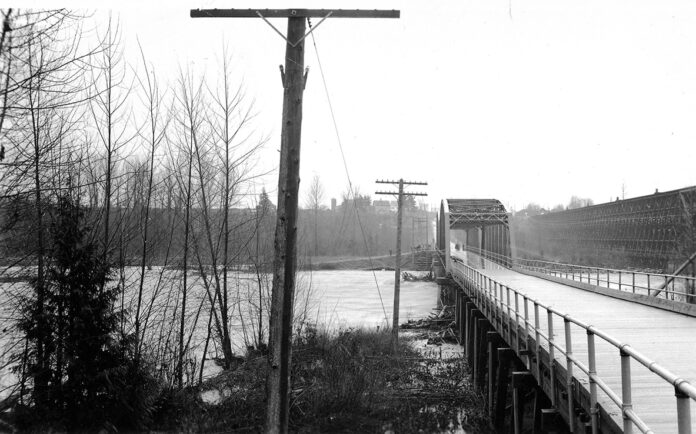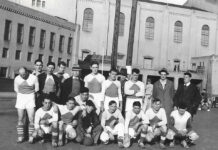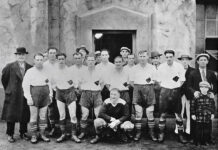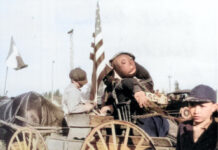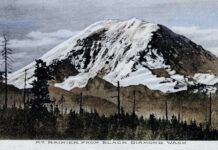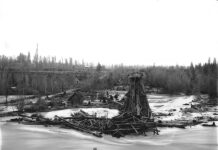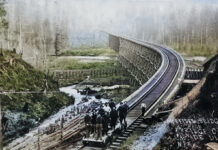Bridges spanning the White River between Buckley and Enumclaw have experienced frequent failures, most recently, the structural damage to the current SR-410 crossing. The mangled SR-410 bridge shouldn’t surprise highway engineers or the 22,000 vehicles that cross each day. Many will recall the 2013 disaster when an oversize truck struck the I-5 bridge over the Skagit River. The news made national headlines and shut down Washington State’s primary interstate for nearly a month.
Five days after that spectacular accident, a front-page Seattle Times article noted that the White River Bridge, built six years before the Skagit River crossing, shared the same design and was “fracture-critical,” meaning the entire structure might fail in the event of serious impact. The article added that the SR-410 “clearance is four inches lower than the Skagit River span.”
The Old Buckley Bridge, seen here in 1933, was constructed in 1915 and remained in service until 1955, six years after the current SR-410 crossing opened in 1949. The Northern Pacific Railway bridge is visible to the right. SR-410 is one of Washington’s oldest cross-state routes. It dates to 1897, when a series of roads connecting King and Pierce Counties to Yakima were approved. By 1907, the highway was known as the White River–Naches Road.
For thousands of years, the White River flowed freely from its source, the Emmons Glacier, on the northeast face of Mount Rainier, the largest glacier in the contiguous United States. In fact, the Osceola Mudflow that raced down the White River about 5,600 years ago covered the entirety of the Enumclaw plateau with 3.8 billion cubic yards of fast-flowing mud, equivalent to about 318 million dump truck loads.
Fittingly, bridges at this fraught location have seen their share of failures. Severe flooding in November 1906 altered the White River’s course, which historically flowed into the Green River to form the Duwamish River, then emptied into Seattle’s Elliot Bay. The event intensified the ongoing dispute between King and Pierce County farmers, known as the ‘River War.’ Neither faction wanted the White River flooding their fields. After seven years of legal battles, a 1913 settlement permanently diverted the White River into the Stuck and Puyallup Rivers, with King County agreeing to cover 60% of the flood control costs.
The 1906 flooding destroyed an earlier vehicle bridge, a predecessor to the Old Buckley Bridge. In March 1908, high waters carried away a temporary replacement, while a log jam threatened the Northern Pacific bridge. By the early 1910s, with increased traffic from trucks and automobiles, the need for a better highway bridge connecting Enumclaw to Buckley was apparent. Plans for the Old Buckley Bridge, dated July 21, 1914, show a design that stretched a quarter mile in length, with two connecting trestles: one measuring 511 feet from the Enumclaw side and another measuring 620 feet on the Buckley side.
The Parker Truss connecting bridge measured 342 feet with two pier-block footings at the mid-point. Back then, the bridge joined the Mud Mountain Dam Road on the Enumclaw side to River Avenue on the Buckley end. The new footbridge, which opened in September 2024, follows the same route. Both the Old Buckley Bridge and the new pedestrian crossing are 160 feet east of and upstream from the former Northern Pacific Railway crossing, and another 900 feet upriver from the current SR-410 bridge.
Flooding along the Whiter River wasn’t fully resolved until 1948, when the Army Corps of Engineers completed the Mud Mountain Dam, pursuant to a 1936 act of Congress. Bids for the project were accepted in 1939, with an expected completion date of November 1942; however, World War II delayed completion by six years.
Following the 1949 construction of the new SR-410 bridge, the Old Buckley Bridge lost its importance. On June 27, 1955, the King County Commissioners adopted a resolution to close the 40-year-old bridge. The Commissioners noted that continued use was dangerous, plus with the SR-410 crossing, it was no longer needed.
Still, one final chapter remained. On January 30, 1956, Buckley Deputy Sheriff Harold Webb reported “the capture of a youth of 17, who admitted that he and two other juveniles attempted to dynamite the bridge.” The three obtained a case of dynamite from one of their fathers and ignited a fuse, but the powder failed. On a second attempt, they poured gasoline on and set fire to the explosives, but the charge still failed to ignite. The Old Buckly Bridge was soon dismantled, as was the Northern Pacific railroad bridge decades later.
The SR-410 bridge, now under repair, opened in 1949 with a projected lifespan of 75 years. For those too tired from driving three extra hours each day, the existing bridge’s expected service life ended in 2024. As did the patience of the 22,000 drivers who typically cross this span each day.
This series 474, file 1060 image comes courtesy of King County Archives. Bridge inspector Thomas Blum took this photo on December 10, 1933. Due to high river levels, the bridge was temporarily closed. A group of citizens can be seen standing on the Buckley side observing the intense winter flooding. JoAnne Matsumura, an Issaquah historian, provided articles from the Seattle Times. Technical information was provided by Steve Faulkner of Enumclaw, a forest engineer who specializes in bridges.

